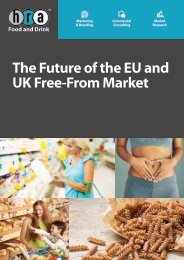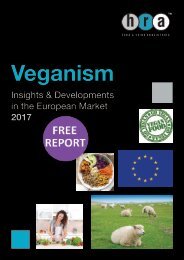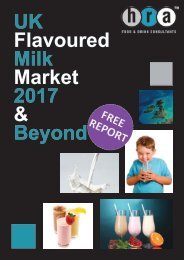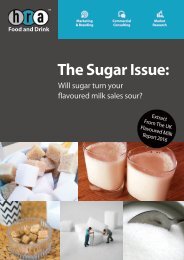FREE-UK-Flavoured-Milk-Report-2016-2017
The backdrop to the UK flavoured milk market is one of relentless change. The removal of the EU milk quotas, the transition to a Western-type diet by emerging economies, the UK sugar debate and the booming sports nutrition industry are all aspects of change that create both challenges and opportunities for the UK flavoured milk market. HRA Food and Drink Marketing has developed this report as a map to guide industry stakeholders. Although volume growth in 2014 was slightly lower than in previous years, the flavoured milk market still has plenty of room for product innovation and development. Overall, we expect the UK flavoured milk market to continue to grow over the medium term, but not without improving its nutritional profile. The sugar debate reached new heights when, in October 2015, Public Health England released a document suggesting Government intervention in the form of a sugar tax (levy). As a consequence, product reformulation has become a priority for all serious players in the market.
The backdrop to the UK flavoured milk market is one of relentless change. The removal of the EU milk quotas, the transition to a Western-type diet by emerging economies, the UK sugar debate and the booming sports nutrition industry are all aspects of change that create both challenges and
opportunities for the UK flavoured milk market.
HRA Food and Drink Marketing has developed this report as a map to guide industry stakeholders. Although volume growth in 2014 was slightly lower than in previous years, the flavoured milk market still has plenty of room for product innovation and development.
Overall, we expect the UK flavoured milk market to continue to grow over the medium term, but not without improving its nutritional profile. The sugar debate reached new heights when, in October 2015, Public Health England released a document suggesting Government intervention in the form of a sugar tax (levy). As a consequence, product reformulation has become a priority for all serious players in the market.
Create successful ePaper yourself
Turn your PDF publications into a flip-book with our unique Google optimized e-Paper software.
<strong>UK</strong>#FLAVOURED#MILK#<strong>2016</strong>217#<br />
#<br />
Figure 6 - 25 Examples of Sugar Reduction Strategies in <strong>Milk</strong> Drinks<br />
Modifying/ reducing lactose<br />
To Gain Access<br />
Purchase The Full<br />
Reducing/ eliminating lactose is a relatively common way of reducing the<br />
<strong>Report</strong> Now<br />
inherent sugar content of milk drinks. Coca Cola’s US Fairlife product and<br />
both of Arla’s <strong>UK</strong> reduced sugar flavoured milk products utilise lactase<br />
enzymes to help reduce the sugar content in their milk. This technique is<br />
often paired with some sort of sweetening agent.<br />
Reformulating flavoured milk with sugar substitutes<br />
There are various artificial sweeteners including aspartame and sucralose<br />
which are widely used in the beverage To Gain industry Access as well as various sweeteners<br />
which are being developed by Purchase ingredients The companies. Full However, due to<br />
common negative associations with artificial sweeteners, the use of natural<br />
sweeteners is often preferred by flavoured<br />
<strong>Report</strong><br />
milk<br />
Nowmanufacturers.<br />
Natural Sweeteners Frequently Used<br />
Inulin/ chicory root fibre: In terms of natural sweeteners, chicory root fibre<br />
is an ingredient which can help with both fat and sugar reduction. It is a clean<br />
label ingredient and can help mask the flavours associated with some highintensity<br />
sweeteners. It is the inulin compound within it which is key to its<br />
sweetening properties. Arla’s <strong>Flavoured</strong> <strong>Milk</strong> products use inulin from chicory<br />
to reduce the sugar content in their formulation by 50%.<br />
Stevia is a commonly used natural sweetener which can be used as a<br />
replacement for sugar. While it is often associated with a liquorice-like<br />
aftertaste, # recent developments have led to compounds with less of the<br />
aftertaste. This has been used successfully To Gain Access in Coca Cola Life as well as the<br />
Skinnygirl Protein product shown in the table above.<br />
Purchase The Full<br />
<strong>Report</strong> Now<br />
Allulose is another natural sweetener which has about 70% of the sweetness<br />
of table sugar with 10% of the calories. Although it has been granted GRAS<br />
(Generally Regarded as Safe) status to Tatle & Lyle’s Dolcia Prima brand of<br />
allulose, it has not yet been approved by Europe.<br />
Monk Fruit Extract is a no calorie sweetener which is 150-200 times<br />
sweeter than sugar. It is a relatively expensive ingredient and although it has<br />
been granted approval in the US, it has not yet by the EU.<br />
Of course, there are a wide range of sweeteners available. Here we have just<br />
highlighted some of the common ones used in dairy. The question of which<br />
© <strong>2016</strong> Teepee Limited. All Rights Reserved.<br />
173







